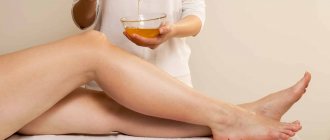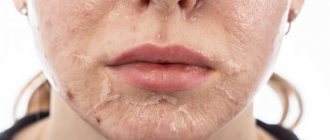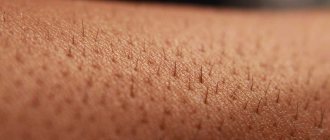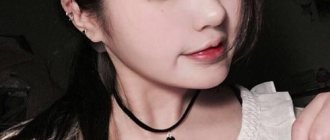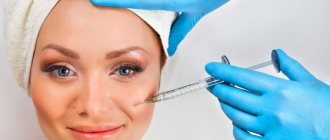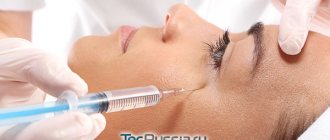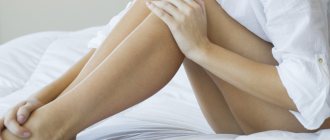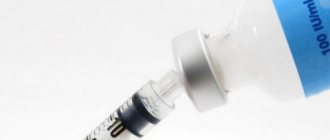Today, both men and women increasingly want to remove hair, which, in their opinion, spoils the aesthetic appearance of one or another part of the body.
The choice of depilation and hair removal methods is large.
In this article we will talk about the most effective and expensive of them - photoepilation, in particular, photoepilation of facial hair.
Benefits and effectiveness of the procedure
Photoepilation is one of the methods of hair removal, that is, the removal of hairs from the bulb. The principle of the method is the impact of a specially focused beam of light on the hair, which allows you to safely, painlessly and contactlessly remove hair over a large area of the body.
Light is absorbed by melanin contained in the hair shaft. As a result of heating the rod, the cells that are responsible for hair growth are destroyed. The follicle is destroyed completely and irrevocably - hair will no longer be able to grow in this place.
Unlike others, this hair removal method has a number of advantages:
- the speed of the procedure - for example, it takes only 15 seconds to remove hair from the upper lip, during which three flashes of light are produced. In general, the procedure on any part of the body takes from 5 to 20 minutes;
- versatility - photoepilation, unlike laser hair removal, can be used by people with any skin and hair color (except gray and white), it can be performed on any part of the body;
- accompanying processes in the form of skin regeneration and rejuvenation, production of elastin and collagen;
- integrity of the skin – during the procedure the device does not come into contact with the skin, the light beam may damage it slightly;
- complete removal of hair in six to eight sessions at intervals of two weeks to one and a half months;
- duration of the effect - after the first procedure, you can forget about your hair for five months, subsequently it will grow thinner and sparser.
Did you know?
Radiation during photoepilation is similar in structure to sunlight, but without ultraviolet radiation. Intense Pulsed Light (IPL) was first used to destroy hair in 1997.
Is it effective and how long does the result last?
It is the long-term preservation of smooth skin that is the main reason for choosing this hair removal method. However, this procedure has other advantages and benefits:
- No contact with skin when exposed to hair
- Minimizing possible damage to the surface layers of the skin
- No risk of infection
- The speed of the session (from five minutes to half an hour)
- Positive effect on the skin due to an effect similar to photorejuvenation (activation of collagen production)
Photoepilation does not apply to gray or very light hair, since they do not contain melanin. A noticeable result appears after the first session of the procedure: intense hair loss is observed. Re-growing hair becomes sparse and thin, but to achieve maximum effect it may take 3 to 7 visits to a cosmetologist. The pain varies from person to person, usually the impulse is compared to the click of a rubber band on the skin.
Who shouldn't sign up?
No matter how strong the desire to get rid of unwanted hair, there are a number of clear contraindications in which this procedure is prohibited.
Neglecting these contraindications can have a detrimental effect on your health and, as a result, the procedure will cause more harm than good.
- Allergic reactions (skin manifestations in the acute stage)
- Exacerbations of any chronic skin diseases
- IHD, arterial hypertension
- Herpes in the acute stage
- Keloid disease
- Any neoplasms on the skin
- Phlebeurysm
- Acute infectious and parasitic pathology
- Pregnancy, lactation
Causes of increased facial hair
The face is the most problematic area for hair removal:
- Firstly, because this area is always open and all the damage on it is too noticeable.
- Secondly, since the skin on the face is very sensitive and any impact on it can lead to undesirable results in the form of allergic rashes, tumors, soreness, etc.
If facial hair is a natural factor for men, then for women it usually forms the basis of complexes and discomfort. There may be several reasons for increased facial hair in women:
- hormonal disorders (excess of male hormones androgens, which can be a consequence of diseases of the ovaries, adrenal glands, brain and pregnancy);
- metabolic and endocrine disorders associated with bad habits, malfunction of the thyroid gland, obesity;
- heredity;
- side effect when treated with hormonal drugs;
- period of puberty.
Did you know?
Excessive hair growth on the body of women due to an excess of male hormones is called hirsutism in medical practice. Excessive hair growth – hypertrichosis. It can be observed in both women and men.
It is women who most often look for ways to get rid of problematic facial hair and are faced with the problem of choice, since not all methods are suitable for this part of the body. For example, when shaving, hair will grow more intensively, thicker, and stubble will appear. Waxing and sugaring are painful and lead to severe irritation. The most effective methods of facial hair removal are laser and photoepilation.
What is photoepilation
Photoepilation is a procedure for removing unwanted hair using high-pulse light. The essence of the procedure is that the melanin contained in the hair structure absorbs light, and under the influence of this light the hair follicle ceases to receive nutrients and is destroyed. As a result, unwanted hair falls out.
Photoepilation can be done anywhere: in the bikini area, on the legs, in the armpits, etc.
Preparing the face
As with other methods, the effectiveness of photoepilation directly depends on proper preparation for it. The first step is to seek advice from a specialist, for example a dermatologist, who should determine whether you have contraindications to this procedure.
To prepare your face for photoepilation, you need to:
- stop sunbathing two weeks before the scheduled session;
- do not use self-tanning preparations;
- when going outside, protect your face with a hat with a visor or wide brim, and also use sunscreen with a filter of at least SPF 30;
- a few weeks before doing photoepilation on the face, abandon any methods of hair removal, including plucking and waxing;
- Avoid taking medications, in particular antibiotics and tranquilizers.
Advice ! The length of the hairs on the day of the procedure should be 1-2 mm.
Photoepilation
Hi all!
I, like many girls, am already tired of “living” with a razor and epilator! Honestly, at such moments I am incredibly jealous of men with their ability to let go of 3-day brutal stubble))))
After deciding for a long time and choosing between epilations, I settled on the photo.
Firstly, it is relatively affordable, and secondly, it seems like there are satisfied customers.
Well, thirdly, probably in the main ones, in the salon I visit, they only take photos)))
So let's get down to business. For the first time, I chose the area of the armpits (armpits in common parlance).
What we have: before this I removed hairs with an epilator, when there was no time or opportunity - with a machine, but extremely rarely. The hair is thin, not very dark, but the skin is white-white. So the contrast is quite big. 3 hairs grow from one bulb.
Before the photo, I was told not to do anything other than shaving for at least 3 months (so that all the bulbs would wake up). This was the first test for me.
The next test was that on the eve of hair removal you have to grow “brutality” there - 3 days, at least not removing anything, so that the hairs become 1-3 mm in length. This is due to the specifics of the procedure - photo flashes affect only the hair, transmitting the impulse through it to the hair follicle. If the hair is too short, then it simply will not be able to absorb this impulse, and if it is too long, then the impulse will lose its intensity until it reaches the follicle, and, of course, there will be no result.
Next, let's go over the procedure a little. So, the epilation site should be clean, but not washed with soap or alcohol-containing product! That is, either with plain water or, as I usually do, wiped with wet wipes. The cosmetologist applies a special cooling gel, puts on glasses for you (like in a solarium), in my case, hands behind your head, in the case of a bikini, the “butterfly” pose (I learned this for the future). And the procedure begins. The device processes small areas, the number of flashes is counted. The cosmetologist enters the date of the visit, power (we will return to this later) and the number of flashes into your personal card.
The procedure must be repeated every 3 weeks for the first 3 months, then at least once a month (another 3-4 months), then once every one and a half to two months. But your cosmetologist will tell you about this based on the results.
Upon completion of the procedure, the cooling gel is removed; nothing else needs to be applied. Then I was strongly advised not to remove my hair for as long as possible. After two or three days, if you have enough nerves not to shave off your primitiveness, you may notice how they begin to fall out. You can pull it lightly with your fingers, and hairs remain in your hands. But, I repeat, to watch this, you need mega-nerves and, apparently, a complete lack of personal life. This only happened to me once.
But not everything is as smooth and sweet as it might seem at first glance.
Firstly, as you have already noticed, this is the inconvenience of “growing out”. I can’t even imagine HOW you can do this with your feet!!!
Secondly, the procedure is painful. Sometimes it stings a lot. And I have a very low pain threshold (believe me, after regular hair removal I’m not afraid of anything)))
Thirdly, a week BEFORE and a week AFTER you should avoid the sun. It's complicated. Especially in summer.
Fourthly, it is very long and tedious. Your hair will not leave you in a month or a year... I’ve been going for almost a year and a half now and YES, there is a result, BUT! He is very, very weak. But more on that a little later)))
And finally, fifthly, this is often the dishonesty of our cosmetologists.
And that's what I mean. Let's estimate the money a little: in my case, for the first six months the cost was fixed: 1,800 rubles/procedure. Then they count by flashes. But, even after a year, I have never had anything cheaper than 800-900 rubles. On the one hand, this is not a lot, but on the other...do the math: 6*1800 + 12*800, in total, I have already spent 20,400 rubles...not bad, right?
Every time the cosmetologist tells me that later there will be 100-200 rubles per session, but, apparently, this is closer to my old age)))
The number of outbreaks is counted by the cosmetologist himself. No matter how you try, as long as you lie with your eyes closed, you will not be able to accurately count them. Accordingly, we can only hope for the doctor’s honesty.
In addition, the power of the photoepilation device is regulated. And there is such a thing: at first you are epilated at a higher power, so that you see the result and hope for smooth skin without hair, and then the power is gradually reduced and, naturally, the hairs stop coming out, and you continue to pay regularly. And it seems like giving up this business, since there is no result, but, looking back and counting the money spent, somehow I don’t want to retreat, so that all this does not go to waste. And, believe me, I’m not a terrible skeptic - this, unfortunately, is the reality of life.
So, after a year and a half of photoepilation, I still didn’t get rid of my hair. And, yes, I will continue, because I simply don’t see the point in stopping. But the result upset me very much and I definitely won’t take photos of other areas of my body.
However, I noticed one such thing. Cosmetologists scream with foam at the mouth, forbidding hair removal after photoepilation from the roots. And I, like an exemplary girl, listened to them all this time. But now it’s summer, and shaving my armpits every day is an incredible torment for me, so, sorry, I freaked out, took out an epilator, and decided that it obviously couldn’t get any worse. And you know what?! Apparently thanks to the photo, due to the fact that the hair follicles have become quite weak, I now do hair removal about once a week. Here is a definite “+”!
I'm going to continue after my vacation (2 weeks + a week after exposure to the sun). As soon as there is new interesting information, I will definitely unsubscribe. But I strongly recommend that if you decide to take a photo, go to trusted doctors.
Thank you all for your attention, and I have a nice holiday!!!
How does a facial photoepilation session work?
- During a photoepilation session, the client lies down on a couch. His eyes are protected with special safety glasses.
- A gel is applied to the area where the light pulse is planned to be exposed, which can protect the skin from damage and burns.
- A manipulator with a tip is carried along the entire area where hair is removed.
- After the procedure is completed, the cosmetologist wipes off the gel and applies a soothing cream.
Photoepilation of the upper lip will take 5-10 minutes, chin – 10-15 minutes, eyebrows – 5-10 minutes.
The duration of the effect will depend on the following factors:
- individual characteristics of the body;
- cosmetologist qualification;
- equipment quality;
- correctly selected power and penetration depth of the light beam.
You can evaluate the effect of facial photoepilation by looking at the photo before and after the procedure.
Procedure
It makes the most sense to do photoepilation in a salon with a specialist on recommendation. The professionalism of the specialist determines how many procedures you will undergo, whether it will hurt you, and how long you will get rid of your hair. First, a light-conducting cooling gel is applied to the skin and protective glasses are put on both the technician and the patient. Then, impulses are sent to the desired area using the device, affecting the hairline. These impulses may feel like tingling or burning, in which case tell a specialist and he will reduce the intensity of the outbreak. One session lasts from 15 minutes to an hour and a half, depending on what area of the body you are performing the procedure on.
Applying gel polish at home: description and recommendations
Learn how to make chic 4-strand braids! Details at this address:
How many times does the procedure need to be performed?
To achieve maximum effect, it is necessary to undergo three to eight sessions at intervals of 1-1.5 months. The number of visits to the salon will depend on skin type, hair color and structure, and individual characteristics of the body. Learn more about how many procedures are required and how long the effect lasts.
After completing the full course, the duration of which will be determined by the salon cosmetologist, it will be necessary to carry out a preventive procedure once every six months.
How long does the effect last?
If you decide that photoepilation will be your method, how long does the effect last is a completely reasonable question.
Reviews for the procedure are very different, which only confirms the individuality of the result. The structure of hair and skin, human nutrition - everything affects the effect of any intervention. However, experts in the field of dermatology say that the effect of photoepilation can last up to several years. If necessary, the procedure is repeated.
However, even under such conditions, photoepilation remains the most reliable and long-term method of hair removal.
Recommended reading
- How many photoepilation sessions are needed for effective hair removal?
- Intimate photoepilation is a way to get rid of unwanted hair in a delicate place once and for all
- Preparation for photoepilation and contraindications, what do you need to know before the procedure?
- Photoepilation: prices that pleasantly please everyone who cares about their appearance
What to do after the procedure
Immediately after the procedure, swelling, redness and slight pain in the treated area may be observed. These effects should subside within a couple of hours. If they persist, it is necessary to cool the treated area. It is possible to use painkillers.
Also, the salon may recommend using Panthenol or other drugs with a similar effect for some time.
The rehabilitation period after photoepilation ranges from five to seven days . At this time, it is advised to refrain from visiting the pool, sauna, bathhouse, as well as from applying cosmetics, especially alcohol-containing products, to the face.
After the procedure, you should not sunbathe for two weeks, limit your time in the sun and use sunscreen (SPF 30 or higher).
Contraindications
Despite the safety of the procedure, photoepilation has a number of contraindications and can lead to negative consequences on the face.
The following people are prohibited from resorting to hair removal using IPL:
- those suffering from cardiovascular diseases (ischemia, hypertension, etc.);
- with acute herpes;
- with severe allergic reactions to the skin;
- having a history of chronic skin diseases;
- with varicose veins;
- with malignant tumors;
- having keloid disease;
- with ARVI and influenza;
- infected with helminthiasis;
- under 16 years of age;
- pregnant women;
- nursing mothers.
Photoepilation can cause the following reactions:
- burns;
- acne;
- exacerbation of herpes;
- allergies;
- folliculitis;
- eye damage;
- violation of skin pigmentation (appearance of light spots);
- scarring;
- paradoxical hypertrichosis (more intense hair growth on the face and neck);
- graying;
- hyperhidrosis;
- malignant formations on the skin (when exposed to IPL on moles and age spots).
